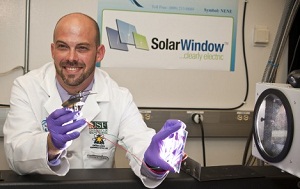Spray-on solar takes big step toward market
 Spray-on solar sounds so simple, like it should be as easy as freshening up with a spritz of perfume. One pump, two pumps and presto: Free energy.
Spray-on solar sounds so simple, like it should be as easy as freshening up with a spritz of perfume. One pump, two pumps and presto: Free energy.
While it’s decidedly not so simple, it is on the horizon. New Energy Technologies, a small solar innovator, has just taken one big step toward introducing its spray-on solar photovoltaic technology to the commercial market.
The company announced earlier this month that it had successfully sprayed a thin layer of nano solar electricity-producing programming onto a 1-foot by 1-foot pane of glass.
The company released a 4-inch by 4-inch prototype earlier in the year.
“You would think that going from the prototype to a 12 by 12 version would be a simple up-scaling,” said New Energy Technologies CEO John Conklin. “but it's orders of magnitude--more complicated.”
He said the challenge has been to maintain uniformity when applying the liquid solar programming to glass while maintaining as much efficiency as possible and an aesthetically pleasing and mostly transparent surface.
The successful up-scaling of the product is a huge milestone for New Energy Technologies, Conkiln said.
“The solar window concept has come a long way,” he said. “It started out as a quarter of the size of a grain of rice.”
Having been able to scale the product up to this realistic level, New Energy is ready to dive into the next strokes toward the commercial market with its spray-on solar, Conklin said.
The next steps involve testing for durability, product performance and reliability, Conklin said.
The company will employ a third-party institution such as a university or the National Renewable Energy Lab in Golden, Colo., to do the testing and come up with performance figures that will then be released to the public.
Among those performance figures will be the efficiency rating of the product, Conklin said.
In relation to monocrystalline solar photovoltaic panels, those commonly mounted on rooftops, the spray-on solar will be significantly less efficient, Conklin said. The spray is designed to capture light energy from both artificial and sunlight and transform that into electricity. The company envisions the products being of especially good use in tall skyscrapers with hundreds and thousands of windows, but small roofs.
“What we lack in efficiency, we will make up for in surface area,” Conklin said.
He expects this year to be a big one for New Energy Technoloies and their new spray-solar product.
“2011 is mapping out to be a very big year for us,” he said.
Image courtesy of New Energy Technologies.



